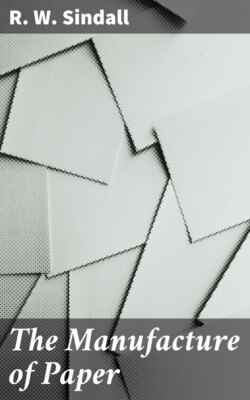Читать книгу The Manufacture of Paper - R. W. Sindall - Страница 6
На сайте Литреса книга снята с продажи.
The First Fourdrinier Paper Machine.
ОглавлениеTable of Contents
Up till the year 1799 paper was made entirely in sheets on a hand mould, but during the last few years of the eighteenth century a Frenchman, Nicholas Louis Robert, manager for M. Didot, who owned a paper mill at Essones, had been experimenting for the purpose of making paper in the form of a continuous sheet, and eventually produced some of considerable length.
The idea was taken to England by Didot's brother-in-law, Gamble, and introduced to the notice of Messrs. Fourdrinier, wholesale stationers, of London.
Fig. 4.—The First Paper Machine, A.D. 1802. Plan and Elevation.
The first machine was naturally a very crude affair. It consisted of an endless wire cloth stretched in a horizontal position on two rollers, one of which rotated freely in a bearing attached to the frame of the machine, the other being fitted in an adjustable bearing so that the wire could be tightened up when necessary.
The beaten pulp, contained in a vat placed below the wire, was thrown up in a continual stream upon the surface of the wire, and carried forward towards the squeezing rolls. A shaking motion was imparted to the travelling wire so as to cause the fibres to felt properly. A great deal of the water fell through the meshes of the gauze, and further quantities were removed by means of the press rolls. The wet paper was then wound up on to a wooden roller, which was taken out as soon as sufficient paper had been made.
Fig. 5.—The Improved Paper Machine of A.D. 1810.
The whole process was carried on under great difficulties, but substantial improvements were soon made by the enterprising Fourdriniers, who commenced operations in Bermondsey, employing Mr. Bryan Donkin, then in the service of Messrs. Hall & Co., of Dartford, who had shown himself keenly interested in the machine. In 1803 the first “Fourdrinier,” so called, was built at Bermondsey, and erected at Two Waters Mill in Herefordshire.
In this machine the mixture of pulp and water was carried forward between two wires, and, after passing through the couch rolls, transferred to an endless felt. This arrangement proved to be faulty because the water did not escape freely enough from the wire, and a great deal of the paper was spoilt.
Donkin, however, hit upon a simple but effective device for curing this fault by altering the relative position of the two couch rolls. Instead of keeping the two rolls exactly in a vertical position one over the other, he placed them at a slight angle so that the upper one should bear gently on the web of paper carried by the wire before receiving the full pressure of the rolls, and thus remove a greater proportion of the water. In this way the paper was firmer and less liable to break when pressed between the couch rolls, an additional advantage being secured in the fact that the upper wire could be dispensed with.
The various improvements effected resulted in a machine the details of which appear in the appended diagram, the device of the inclined couch rolls being fitted about 1810.
The mixture of water and pulp flowed from a stuff chest into a small regulating box and on to the wire over a sloping board. The pulp at once formed into a wet sheet of paper, the water falling through the meshes of the wire, being caught in a bucket-shaped appliance, and conveyed back to the regulating box. The stream of pulp was confined upon the wire by means of a deckle. Further quantities of water were removed by the aid of a pair of squeezing rolls before the web passed through the couch rolls after which the paper was reeled up on a wooden spindle.
From this date the success of the machine was assured, though the inventor and his colleagues were practically ruined, an experience only too common with the early pioneers of many great and useful industrial enterprises. In fact, the firm of Messrs. Donkin were the only people to profit from the invention, for they manufactured a number of machines, as stated in the report of the Jurors of the Exhibition of 1851, and from 1803 to 1851 no less than 190 Fourdriniers were set to work.
